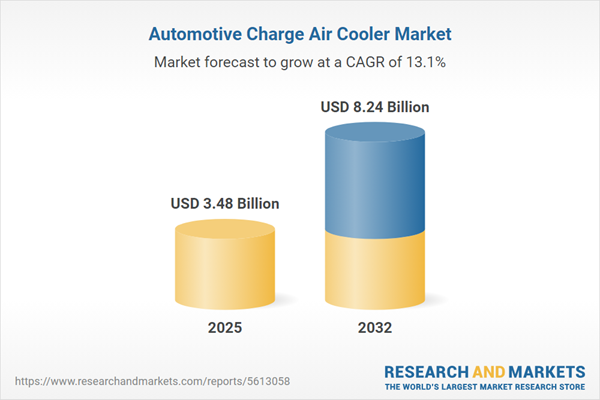Speak directly to the analyst to clarify any post sales queries you may have.
Senior leaders in the automotive sector are navigating a rapidly changing charge air cooler market, shaped by advancements in vehicle powertrain technologies and complex global compliance requirements. Adapting operational and product strategies is essential for maintaining a competitive edge in this evolving landscape.
Market Snapshot: Automotive Charge Air Cooler Market
The automotive charge air cooler market is experiencing robust expansion, with a 2024 valuation of USD 3.08 billion projected to rise to USD 3.48 billion in 2025 and USD 8.24 billion by 2032, underpinned by a 13.08% CAGR. Growth is propelled by widespread adoption of turbocharged engines in both commercial and passenger vehicles, elevating the critical role of charge air coolers in meeting emissions and efficiency requirements. As regulatory standards become more stringent globally, technological innovation in thermal management is reshaping industry standards. Both OEMs and aftermarket suppliers are adopting new solutions to achieve compliance, improve performance, and support operational dependability, driving shifts in supply chain relationships and product offerings.
Scope & Segmentation: Charge Air Cooler Market Coverage
Comprehensive segmentation enables decision-makers to align strategies across products, technologies, and global regions. This framework supports optimized investments and tailored solutions for diverse operational needs.
- Cooler Types: Air-to-air and air-to-water charge air coolers accommodated for differing thermal management strategies and emission targets within broad vehicle platforms.
- Vehicle Types: Inclusion of commercial trucks, off-highway agricultural and construction equipment, and standard passenger vehicles, addressing the variability in operational demands and segment-specific strategy formulation.
- Fuel Types: Diesel, gasoline, and hybrid engine coverage to reflect shifts in powertrain preference and evolving efficiency expectations across established and emerging markets.
- Distribution Channels: Analysis of OEM supply chains as well as independent aftermarket models, clarifying each channel’s unique value in customer engagement, service, and supply responsiveness.
- Material Types: Focus on trends in aluminum and copper use, offering insights into advanced material applications for both performance improvements and sustainability-focused vehicle lightweighting initiatives.
- Regional Markets: In-depth perspective on Americas, Europe, Middle East & Africa, and Asia-Pacific, outlining approaches to diverse regulatory, technological, and economic conditions affecting these regions.
- Leading Companies: Benchmarking highlights for major industry players including MAHLE GmbH, DENSO Corporation, Valeo SA, Garrett Motion Inc., BorgWarner Inc., Modine Manufacturing Company, Sanden Holdings Corporation, Hanon Systems, Behr GmbH & Co. KG, and Nissens A/S, supporting informed partnership and investment decisions.
Key Takeaways for Senior Decision-Makers
- Modular product architectures offer flexibility, enabling rapid adaptation to region-specific regulatory and technical requirements while supporting consistent compliance across markets.
- Adoption of advanced lightweight materials like aluminum and copper is integral to meeting cost strategies and progressing toward sustainability and environmental targets.
- Employing digital engineering and simulation streamlines innovation and accelerates response to shifting efficiency and emissions benchmarks.
- Localized manufacturing and enhanced supplier collaboration strengthen continuity and agility in the face of geopolitical and logistical disruptions.
- Aftermarket and regionally tailored component offerings allow manufacturers to cater to unique operational profiles, supporting differentiated product strategies across varied vehicle fleets.
Tariff Impact: Navigating Global Policy Changes
Shifts in U.S. tariff policies are prompting manufacturers to reconfigure global supply networks. By moving production closer to end markets and fostering vertical integration, organizations mitigate risks associated with international trade. Strong strategic supplier alliances secure critical component availability and help ensure reliable manufacturing operations, supporting stability and consistency despite evolving policy landscapes.
Methodology & Data Sources
This analysis synthesizes input from engineers, procurement specialists, and aftermarket professionals. The research process includes peer review and the latest updates in global automotive regulations, delivering robust, actionable insight to guide investment and regulatory planning.
Why This Report Matters to Industry Leaders
- Provides critical regulatory intelligence and future-oriented analysis, supporting strategic investments and technology adoption amid dynamic market conditions.
- Helps build more resilient, adaptive supply chains, positioning organizations to withstand future operational disruptions.
- Enables executive benchmarking and strategic planning to refine competitiveness and enhance response to industry ecosystem changes.
Conclusion
By leveraging these insights, senior leaders can reinforce supply chain stability, respond effectively to regulatory and policy evolution, and drive product and process innovation in the automotive charge air cooler sector.
Additional Product Information:
- Purchase of this report includes 1 year online access with quarterly updates.
- This report can be updated on request. Please contact our Customer Experience team using the Ask a Question widget on our website.
Table of Contents
3. Executive Summary
4. Market Overview
7. Cumulative Impact of Artificial Intelligence 2025
Companies Mentioned
The companies profiled in this Automotive Charge Air Cooler market report include:- MAHLE GmbH
- DENSO Corporation
- Valeo SA
- Garrett Motion Inc.
- BorgWarner Inc.
- Modine Manufacturing Company
- Sanden Holdings Corporation
- Hanon Systems
- Behr GmbH & Co. KG
- Nissens A/S
Table Information
| Report Attribute | Details |
|---|---|
| No. of Pages | 182 |
| Published | October 2025 |
| Forecast Period | 2025 - 2032 |
| Estimated Market Value ( USD | $ 3.48 Billion |
| Forecasted Market Value ( USD | $ 8.24 Billion |
| Compound Annual Growth Rate | 13.0% |
| Regions Covered | Global |
| No. of Companies Mentioned | 11 |









